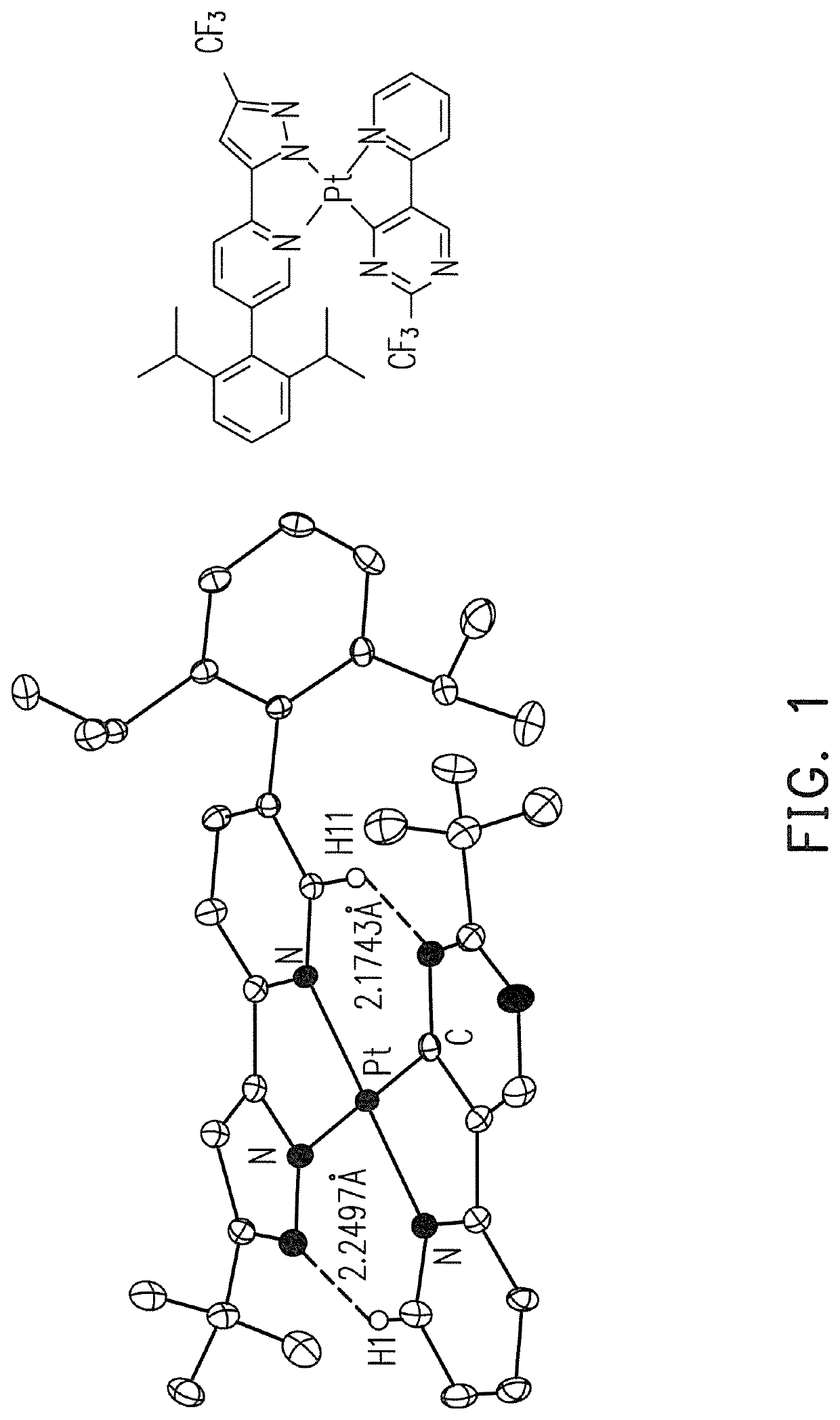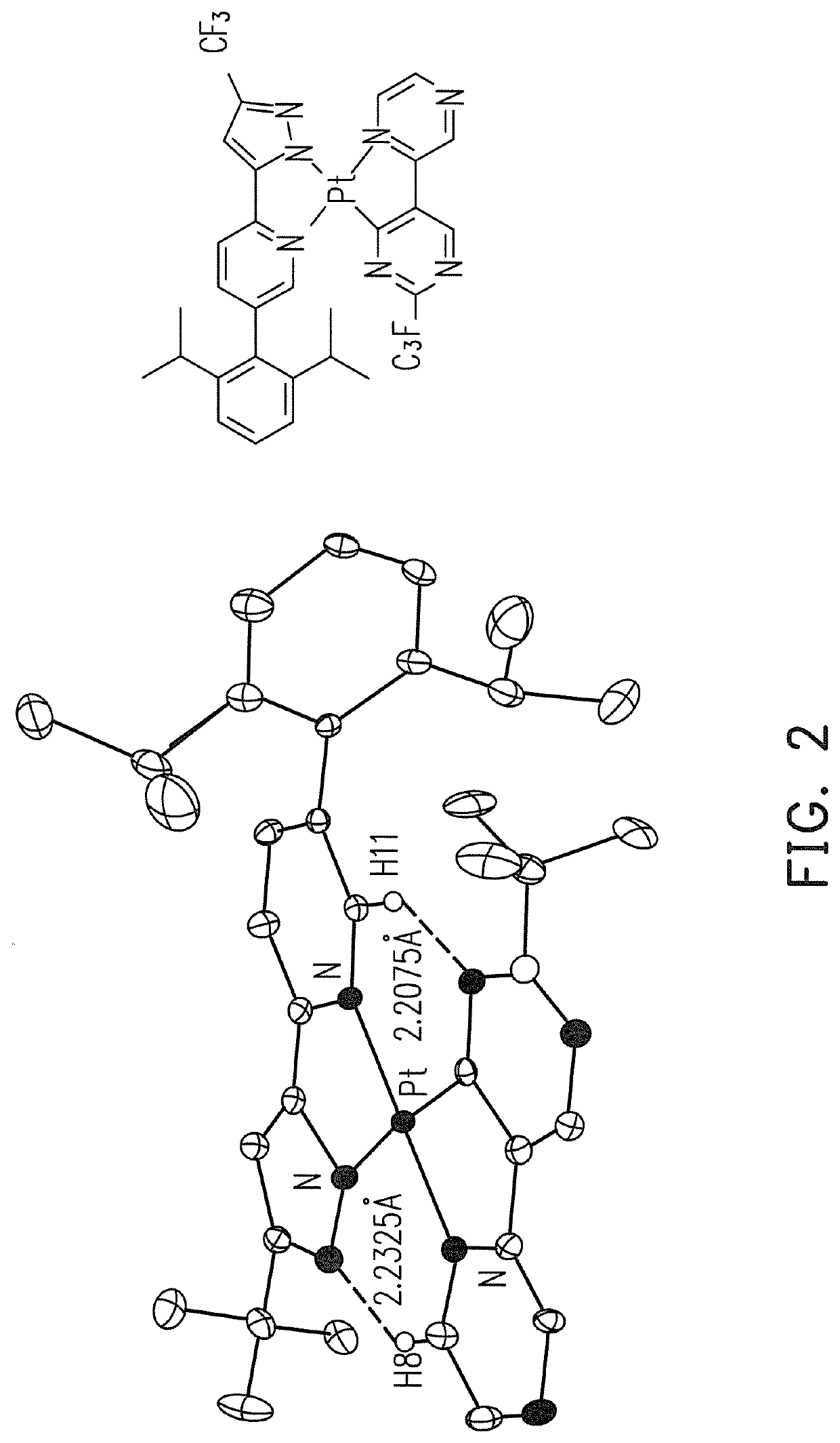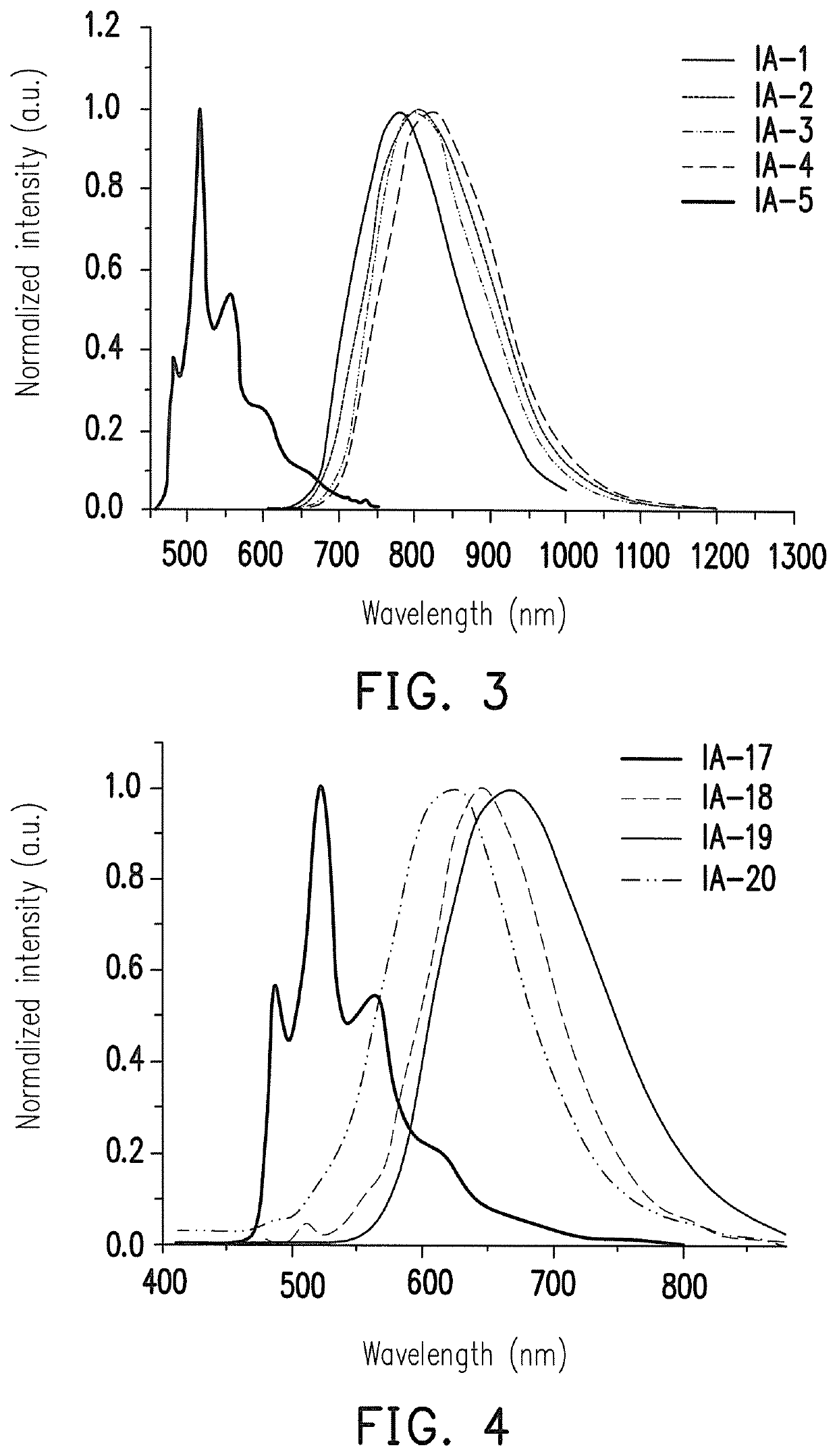Platinum complex, OLED and apparatus for providing visible emission or near-infrared emission
a platinum complex and visible emission technology, applied in the field of platinum complexes, can solve the problems of inconvenient commercial production of existing tetra-coordinated platinum complexes, time-consuming purification steps, etc., and achieve the effects of convenient synthesizing, excellent luminous efficiency, and structural stability
- Summary
- Abstract
- Description
- Claims
- Application Information
AI Technical Summary
Benefits of technology
Problems solved by technology
Method used
Image
Examples
example 1
on of Compound (IA-1)
[0111]
[0112]A mixture of K2PtCl4 (300 mg, 0.723 mmol), ligand precursor L7 (163 mg, 0.723 mmol) and sodium acetate (2.37 g, 28.9 mmol) in 50 mL of glacial acetic acid was refluxed for 2 hours and then cooled to room temperature. Ligand precursor L1 (195 mg, 0.723 mmol) was added and the mixture was further refluxed for 2 hours. The solvent was removed under vacuum and the obtained powder was washed with water, ethyl acetate and CH2Cl2 in sequence. A dark green solid (276 mg, yield: 56%) was obtained after vacuum sublimation.
[0113]Spectral data of compound (IA-1): 1H NMR (500 MHz, d6-DMSO, 323 K): δ 10.61 (s, 2H), 9.12 (s, 1H), 8.41 (d, J=8.0 Hz, 1H), 8.33 (t, J=8.0 Hz, 1H), 8.08 (s, 1H), 7.76 (t, J=6.5 Hz, 1H), 7.52 (d, J=6.5 Hz, 1H), 7.43 (s, 1H), 1.42 (s, 9H). 19F NMR (470 MHz, d6-DMSO, 323 K): δ−59.55 (s, 3F), −69.44 (s, 3F). FD MS: m / z 687.2 (M+). Anal. Calcd. for C23H18F6N6Pt: C, 40.18; H, 2.64; N, 12.22. Found: C, 40.27; H, 2.29; N, 12.22.
example 2
on of Compound (IA-2)
[0114]
[0115]Similar to the synthetic procedure of compound (IA-1), the reaction of K2PtCl4 (100 mg, 0.241 mmol), ligand precursor L7 (54.3 mg, 0.241 mmol) and sodium acetate (790 mg, 9.64 mmol) in 15 mL of glacial acetic acid was carried out, followed by treatment with ligand precursor L2 (51.4 mg, 0.241 mmol) and vacuum sublimation. A dark brown solid (81 mg, 53%) was then obtained.
[0116]Spectral data of compound (IA-2): 1H NMR (400 MHz, d7-DMF, 298 K): δ 10.45 (d, J=5.2 Hz, 1H), 10.28 (d, J=5.2 Hz, 1H), 8.84 (s, 1H), 8.24˜8.17 (m, 2H), 8.1 (td, J=7.6, 1.2 Hz, 1H), 7.8 (d, J=7.2 Hz, 1H), 7.47˜7.44 (m, 1H), 7.31˜7.27 (m, 1H), 6.96 (s, 1H). 19F NMR (376 MHz, d7-DMF, 298 K): δ−60.23 (s, 3F), −69.99 (s, 3F). FD MS: m / z 631.1 (M+). Anal. Calcd. for C19H10F6N6Pt: C, 36.14; H, 1.60; N, 13.31. Found: C, 36.25; H, 1.68; N, 13.56.
example 3
on of Compound (IA-3)
[0117]
[0118]Similar to the synthetic procedure of compound (IA-1), the reaction of K2PtCl4 (300 mg, 0.723 mmol), ligand precursor L7 (163 mg, 0.723 mmol) and sodium acetate (2.37 g, 28.9 mmol) in 50 mL of glacial acetic acid was carried out, followed by treatment with ligand precursor L3 (203 mg, 0.723 mmol) and vacuum sublimation. A dark green solid (304 mg, yield: 60%) was then obtained.
[0119]Spectral data of compound (IA-3): 1H NMR (500 MHz, d7-DMF, 323 K): δ 10.85 (s, 1H), 10.37 (s, 1H), 8.96 (s, 1H), 8.37 (s, 1H), 8.31˜8.28 (m, 2H), 7.72 (s, 1H), 7.58 (s, 1H), 7.36 (s, 1H). 19F NMR (470 MHz, d7-DMF, 323 K): δ−61.08 (s, 3F), −65.83 (s, 3F), −70.67 (s, 3F). FD MS: m / z 699.1 (M+). Anal. Calcd. for C20H9F9N6Pt: C, 34.35; H, 1.30; N, 12.02. Found: C, 34.35; H, 1.64; N, 12.05.
PUM
| Property | Measurement | Unit |
|---|---|---|
| emission wavelength | aaaaa | aaaaa |
| emission wavelength | aaaaa | aaaaa |
| emission wavelength | aaaaa | aaaaa |
Abstract
Description
Claims
Application Information
 Login to View More
Login to View More - R&D
- Intellectual Property
- Life Sciences
- Materials
- Tech Scout
- Unparalleled Data Quality
- Higher Quality Content
- 60% Fewer Hallucinations
Browse by: Latest US Patents, China's latest patents, Technical Efficacy Thesaurus, Application Domain, Technology Topic, Popular Technical Reports.
© 2025 PatSnap. All rights reserved.Legal|Privacy policy|Modern Slavery Act Transparency Statement|Sitemap|About US| Contact US: help@patsnap.com



